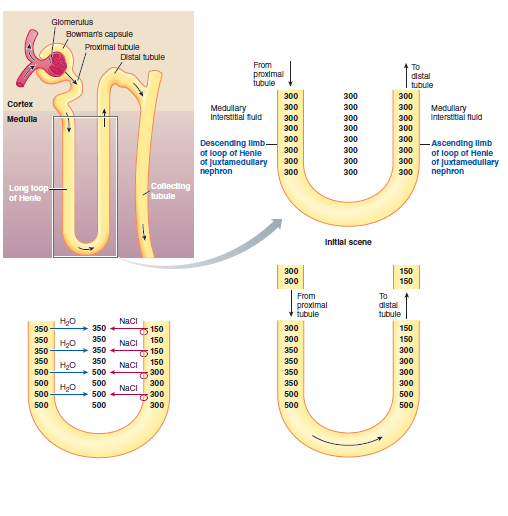
Urine Concentration and Dilution; Regulation of Extracellular Fluid Osmolarity and Sodium Concentration
For the cells of the body to function properly, they must be bathed in extracellular fluid with a relatively constant concentration of electrolytes and other solutes. The total concentration of solutes in the extracellular fluid—and therefore the osmolarity—must also be precisely regulated to prevent the cells from shrinking or swelling. The osmolarity is determined by the amount of solute (mainly sodium chloride) divided by the volume of the extracellular fluid. Thus, to a large extent, extracellular fluid osmolarity and sodium chloride concentration are regulated by the amount of extracellular water. The total body water is controlled by (1) fluid intake, which is regulated by factors that determine thirst, and (2) renal water excretion, which is controlled by multiple factors that influence glomerular filtration and tubular reabsorption. A vertical osmotic gradient is uniquely maintained in the medullary interstitial fluid of each kidney. The concentration of the interstitial fluid progressively increases from the cortical boundary down through the depth of the renal medulla until it reaches a maximum of 1200 mOsm/L in humans at the junction with the renal pelvis. Here we discuss how this gradient enables the kidneys to produce urine that ranges in concentration from 100 to 1200 mOsm/L, depending on the body’s state of hydration.
The students will be able to learn at the end of this lesson;
(1) The mechanisms that cause the kidneys to eliminate excess water by excreting a dilute urine
(2) The mechanisms that cause the kidneys to conserve water by excreting a concentrated urine
(3) The renal feedback mechanisms that control the extracellular fluid sodium concentration and osmolarity
(4) The thirst and salt appetite mechanisms that determine the intakes of water and salt, which also help to control extracellular fluid volume, osmolarity, and sodium concentration.


